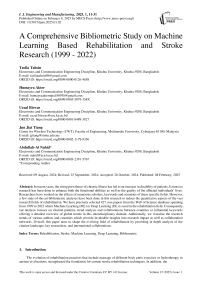A Comprehensive Bibliometric Study on Machine Learning Based Rehabilitation and Stroke Research (1999 - 2022)
Автор: Tasfia Tahsin, Humayra Akter, Uzzal Biswas, Jun Jiat Tiang, Abdullah-Al Nahid
Журнал: International Journal of Engineering and Manufacturing @ijem
Статья в выпуске: 1 vol.15, 2025 года.
Бесплатный доступ
In recent years, the rising prevalence of chronic illness has led to an increase in disability of patients. Extensive research has been done to enhance both the functional abilities as well as the quality of the affected individuals’ lives. Researchers have worked on the effects of numerous scholars, keywords and countries of these specific fields. However, a few state-of-the-art bibliometric analyses have been done in this research to reduce the quantitative aspects of the vast research fields of rehabilitation. We have precisely selected 427 core papers from the Web of Science database spanning from 1999 to 2022 where Machine Learning (ML) or Deep Learning (DL) is used in the rehabilitation field. Consequently, our analysis focuses on citation patterns, trend analysis and collaborations between countries or influential keywords offering a detailed overview of global trends in this interdisciplinary domain. Additionally, we visualize the research trends of various authors and countries which provide invaluable insights into research impact as well as collaboration networks. Overall, this paper aims to shape the evolving field of rehabilitation by providing in depth analysis of the citation landscape, key researchers, and international collaborations.
Rehabilitation, Stroke, Machine Learning, Deep Learning, Bibliometric
Короткий адрес: https://sciup.org/15019641
IDR: 15019641 | DOI: 10.5815/ijem.2025.01.02
Список литературы A Comprehensive Bibliometric Study on Machine Learning Based Rehabilitation and Stroke Research (1999 - 2022)
- T. Tahsin, K. M. Mumenin, H. Akter, J. J. Tiang, and A.-A. Nahid, “Machine Learning-Based Stroke Patient Rehabilitation Stage Classification Using Kinect Data,” Applied Sciences, vol. 14, no. 15, 2024, doi: 10.3390/app14156700.
- Y. Guo, Z. Hao, S. Zhao, J. Gong, and F. Yang, “Artificial intelligence in health care: bibliometric analysis,” J Med Internet Res, vol. 22, no. 7, p. e18228, 2020.
- P. Srisusilawati, A. S. Rusydiana, Y. D. Sanrego, and N. Tubastuvi, “Biblioshiny R application on islamic microfinance research,” Library Philosophy and Practice, vol. 2021, no. 5096, pp. 1–24, 2021.
- X. Xue et al., “Global Trends and Hotspots in Research on Rehabilitation Robots: A Bibliometric Analysis From 2010 to 2020,” Front Public Health, vol. 9, 2021.
- X. Feng, C. Liu, Q. Guo, Y. Bai, Y. Ren, and B. Ren, “Research progress in rehabilitation treatment of stroke patients: a bibliometric analysis. Neural Regen Res. 2013; 8 (15): 1423–30.”
- J.-H. Huang, X.-Y. Duan, F.-F. He, G.-J. Wang, and X.-Y. Hu, “A historical review and Bibliometric analysis of research on Weak measurement research over the past decades based on Biblioshiny,” arXiv preprint arXiv:2108.11375, 2021.
- F. J. Agbo, S. S. Oyelere, J. Suhonen, and M. Tukiainen, “Scientific production and thematic breakthroughs in smart learning environments: a bibliometric analysis,” Smart Learning Environments, vol. 8, no. 1, pp. 1–25, 2021.
- M. Kabil, S. Priatmoko, R. Magda, and L. D. Dávid, “Blue economy and coastal tourism: A comprehensive visualization bibliometric analysis,” Sustainability, vol. 13, no. 7, p. 3650, 2021.
- T. Tahsin et al., “GWO-XGB: Grey Wolf Optimization-based eXtreme Gradient Boosting for Hypertension Prediction in Bangladesh,” in 2021 International Conference on Electronics, Communications and Information Technology (ICECIT), IEEE, 2021, pp. 1–4.
- Z. Xiao, Y. Qin, Z. Xu, J. Antucheviciene, and E. K. Zavadskas, “The Journal Buildings: A Bibliometric Analysis (2011–2021),” Buildings, vol. 12, no. 1, p. 37, 2022.
- A. S. Rusydiana, “Bibliometric analysis of journals, authors, and topics related to COVID-19 and Islamic finance listed in the Dimensions database by Biblioshiny,” Science Editing, vol. 8, no. 1, pp. 72–78, 2021.
- S. Secinaro, V. Brescia, D. Calandra, and P. Biancone, “Employing bibliometric analysis to identify suitable business models for electric cars,” J Clean Prod, vol. 264, p. 121503, 2020.
- W. Yan, X. Liu, B. Shan, and Y. Pu, “Research on the Emotions Based on Brain-Computer Technology: A Bibliometric Analysis and Research Agenda,” Front Psychol, p. 4995, 2021.
- S. Fosso Wamba and M. M. Queiroz, “Responsible artificial intelligence as a secret ingredient for digital health: Bibliometric analysis, insights, and research directions,” Information Systems Frontiers, pp. 1–16, 2021.
- T. Palma Pagano et al., “Machine learning models and facial regions videos for estimating heart rate: a review on Patents, Datasets and Literature,” arXiv e-prints, p. arXiv-2202, 2022.
- Y. Li, Z. Xu, X. Wang, and X. Wang, “A bibliometric analysis on deep learning during 2007–2019,” International Journal of Machine Learning and Cybernetics, vol. 11, no. 12, pp. 2807–2826, 2020.
- J. Dores, T. Biju, and F. Sanu, “Mind the Gap: A Bibliometric Analysis on Unrecognized Role of Women in Fisheries Sector”.


